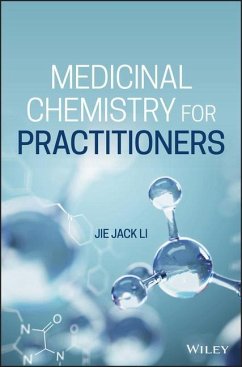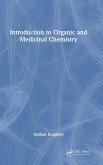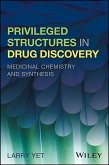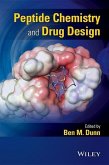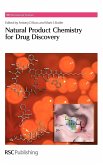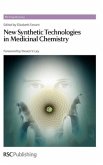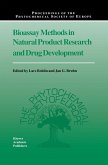Jie Jack Li
Medicinal Chemistry for Practitioners
Schade – dieser Artikel ist leider ausverkauft. Sobald wir wissen, ob und wann der Artikel wieder verfügbar ist, informieren wir Sie an dieser Stelle.
Jie Jack Li
Medicinal Chemistry for Practitioners
- Gebundenes Buch
- Merkliste
- Auf die Merkliste
- Bewerten Bewerten
- Teilen
- Produkt teilen
- Produkterinnerung
- Produkterinnerung
"This book offers a good starting point for new medicinal chemists to jump start a career and a one-stop depository of key drug discovery disciplines for veterans. It discusses different kinds of drug targets and how to select and validate them, drug design, pharmacokinetic properties, and bioisoteres"--
Andere Kunden interessierten sich auch für
![Introduction to Organic and Medicinal Chemistry Introduction to Organic and Medicinal Chemistry]() Nathan KeighleyIntroduction to Organic and Medicinal Chemistry155,99 €
Nathan KeighleyIntroduction to Organic and Medicinal Chemistry155,99 €![Privileged Structures in Drug Discovery Privileged Structures in Drug Discovery]() Larry YetPrivileged Structures in Drug Discovery209,99 €
Larry YetPrivileged Structures in Drug Discovery209,99 €![Peptide Chemistry and Drug Design Peptide Chemistry and Drug Design]() Peptide Chemistry and Drug Design166,99 €
Peptide Chemistry and Drug Design166,99 €![Natural Product Chemistry for Drug Discovery Natural Product Chemistry for Drug Discovery]() Natural Product Chemistry for Drug Discovery193,99 €
Natural Product Chemistry for Drug Discovery193,99 €![Natural Products and Drug Discovery Set Natural Products and Drug Discovery Set]() Natural Products and Drug Discovery Set863,99 €
Natural Products and Drug Discovery Set863,99 €![New Synthetic Technologies in Medicinal Chemistry New Synthetic Technologies in Medicinal Chemistry]() New Synthetic Technologies in Medicinal Chemistry134,99 €
New Synthetic Technologies in Medicinal Chemistry134,99 €![Bioassay Methods in Natural Product Research and Drug Development Bioassay Methods in Natural Product Research and Drug Development]() Lars Bohlin / Jan G. Bruhn (Hgg.)Bioassay Methods in Natural Product Research and Drug Development249,99 €
Lars Bohlin / Jan G. Bruhn (Hgg.)Bioassay Methods in Natural Product Research and Drug Development249,99 €-
-
-
"This book offers a good starting point for new medicinal chemists to jump start a career and a one-stop depository of key drug discovery disciplines for veterans. It discusses different kinds of drug targets and how to select and validate them, drug design, pharmacokinetic properties, and bioisoteres"--
Produktdetails
- Produktdetails
- Verlag: Wiley
- Seitenzahl: 416
- Erscheinungstermin: 23. Juni 2020
- Englisch
- Abmessung: 264mm x 185mm x 27mm
- Gewicht: 946g
- ISBN-13: 9781119607281
- ISBN-10: 1119607280
- Artikelnr.: 58342806
- Herstellerkennzeichnung
- Libri GmbH
- Europaallee 1
- 36244 Bad Hersfeld
- gpsr@libri.de
- Verlag: Wiley
- Seitenzahl: 416
- Erscheinungstermin: 23. Juni 2020
- Englisch
- Abmessung: 264mm x 185mm x 27mm
- Gewicht: 946g
- ISBN-13: 9781119607281
- ISBN-10: 1119607280
- Artikelnr.: 58342806
- Herstellerkennzeichnung
- Libri GmbH
- Europaallee 1
- 36244 Bad Hersfeld
- gpsr@libri.de
JIE JACK LI, PHD has practiced medicinal chemistry since 1997 at Pfizer, BMS, and Revolution Medicines, respectively, with a four-year sojourn at the University of San Francisco as an Associate Professor, teaching medicinal and organic chemistry. He is currently a vice president at ChemPartner, splitting his time between San Francisco and Shanghai. He has authored or edited 30 books and many of those were published by Wiley, including Drug Discovery: Practices, Processes, and Perspectives, Innovative Drug Synthesis, Modern Drug Synthesis, The Art of Drug Synthesis, and Contemporary Drug Synthesis.
Preface vii
Chapter 1. Drug Targets 1
1.1 Selection and Validation of Drug Targets 1
1.1.1 Factors to Consider 1
1.1.2 Target Selection 5
1.1.3 Target Validation 6
1.2 Enzymes 8
1.2.1 Competitive Inhibitor 8
1.2.2 Allosteric Inhibitors 21
1.2.3 Covalent Irreversible Inhibitors 28
1.2.4 Transition-state Mimetics 37
1.2.5 Suicide Substrates 42
1.2.6 Isozyme Selectivity of Inhibitors 45
1.3 Receptors 52
1.3.1 G-Protein-Coupled Receptors 58
1.3.2 Nuclear Hormone Receptors 72
1.3.3 Growth Factor Receptors 79
1.3.4 Ionotropic Receptors 80
1.4 Ion Channels 81
1.4.1 Calcium Channel Blockers 81
1.4.2 Sodium Channel Blockers 83
1.4.3 Potassium Channel Blockers 83
1.5 Carrier Proteins 84
1.6 Structural Proteins 85
1.7 Nucleic Acids 85
1.8 Protein-protein Interactions 87
1.9 Further Readings 89
1.10 References 89
Chapter 2 Hit/Lead Discovery 97
2.1 Irrational Drug Design (Serendipity) 97
2.2 Natural Products 98
2.2.1 From Plants 98
2.2.2 From Animals 101
2.2.3 From Microorganisms 104
2.2.4 From Natural Ligands 105
2.2.5 From Modifying Existing Drugs 106
2.3 High Through-put Screening (HTS) 107
2.4 Fragment-based Lead Discovery 111
2.5 DNA-encoded Library (DEL) 116
2.6 PROTAC 118
2.7 Further Readings 128
2.8 References 128
Chapter 3. Pharmacokinetics (ADME) 133
3.1 Physicochemical Properties 133
3.1.1 Lipophilicity 133
3.1.2 Hydrogen Bonding 138
3.1.3. Polar Surface Area 141
3.1.4 Rotatable Bonds 142
3.1.5 Rule of 5 143
3.1.6 Ligand Efficiency 144
3.1.7 Lipophilic Efficiency 145
3.2 Absorption 146
3.2.1 Definition of Pharmacokinetics Parameters 146
3.2.2 Improving Solubility 150
3.2.3 Absorption by Diffusion 156
3.2.4 Absorption by Active Transports 157
3.2.5 Absorption by Pinocytosis 163
3.3 Distribution 164
3.3.1. Around the Blood Supply, to Tissues, and to Cells 164
3.3.2. Blood-Brain Barrier 167
3.3.3. Efflux Transporters 170
3.3.4. Plasma Protein Binding 175
3.4 Metabolism 179
3.4.1. Overview of Drug Metabolism 179
3.4.2 Cytochrome P450 Enzymes 182
3.4.3. Drug-Drug Interactions 183
3.4.4. Phase I Metabolism 186
3.4.5. Phase II Metabolism 198
3.5 Excretion 205
3.5.1. Renal Excretion 206
3.5.2. Non-Renal Excretion 207
3.6 Pro-drugs 209
3.6.1. Overcoming Formulation and Administration Problems 209
3.6.2. Overcoming Absorption Barriers 211
3.6.3. Overcoming Distribution Problems 214
3.6.4. Overcoming Metabolism and Excretion Problems 214
3.6.5. Overcoming Toxicity Problems 215
3.7 Further Readings 218
3.8 References 218
Chapter 4 Bioisosteres 225
4.1 Introduction to Bioisosteres 225
4.1.1 Definition 225
4.1.2 Utility 225
4.2 Hydrogen Isosteres 232
4.2.1 Deuterium 232
4.2.2. Fluorine 235
4.2.3. Chlorine 239
4.2.4. Methyl 241
4.2 Alkyl Isosteres 243
4.3.1 O for CH2 244
4.3.2 Cyclopropane as an Alkyl Isostere 244
4.3.3 Silicon as an Isostere of Carbon 246
4.3.4 t-Butyl Isosteres 247
4.4 Alcohol, Phenol, and Thiol Isosteres 250
4.4.1 Alcohol 250
4.4.2 Phenol 253
4.4.3. Thiol 257
4.5 Carboxylic Acid and Derivative Isosteres 258
4.5.1 Carboxylic Acid 258
4.5.2 Hydroxamic Acid 270
4.5.3 Ester and Amide 273
4.5.4 Urea, Guanidine, and Amidine 279
4.6 Scaffold Hopping 282
4.6.1. Phenyl 282
5.6.2 Biphenyl 285
5.6.3 N for CH in Aromatic Rings 286
5.6.4 Isosterism between Heterocycles 290
4.7 Peptide Isosteres 293
4.7.1 Cyclization 294
4.7.2. Intramolecular Hydrogen Bonding 295
4.7.3. N-Methylation 296
4.7.4 Shielding 297
4.8 Further Readings 298
4.9 References 298
Chapter 5. Structural Alerts for Toxicity 307
5.1 Reactive Electrophiles 307
5.1.1. Alkylating Agents 308
5.1.2. Michael Acceptors 312
5.1.3. Heteroaromatic Halides 315
5.1.4 Miscellaneous Reactive Electrophiles 317
5.2 DNA Intercalators 318
5.3 Carcinogens 319
5.4 Metabolism Problematic Molecules 321
5.4.1 Anilines and Anilides 321
5.4.2 Problematic Amines 330
5.4.3 Nitroaromatics 336
5.4.4 Quinones and Phenols 340
5.4.5 S-Containing Compounds 345
5.4.6 Hydrazines and Hydrazides 350
5.4.7 Methylenedioxyphenyl Moiety 355
5.4.8 Electron-rich Heteroaromatics 360
5.5 PAINS 368
5.5.1 Unsaturated Rhodanines 368
5.5.2 Phenolic Mannich Bases 371
5.5.3 Invalid Metabolic Panaceas 373
5.5.4 Alkylidene Barbituates etc. 373
5.6 Conclusions 375
5.7 Further Readings 375
5.8 References 376
Index 383
Chapter 1. Drug Targets 1
1.1 Selection and Validation of Drug Targets 1
1.1.1 Factors to Consider 1
1.1.2 Target Selection 5
1.1.3 Target Validation 6
1.2 Enzymes 8
1.2.1 Competitive Inhibitor 8
1.2.2 Allosteric Inhibitors 21
1.2.3 Covalent Irreversible Inhibitors 28
1.2.4 Transition-state Mimetics 37
1.2.5 Suicide Substrates 42
1.2.6 Isozyme Selectivity of Inhibitors 45
1.3 Receptors 52
1.3.1 G-Protein-Coupled Receptors 58
1.3.2 Nuclear Hormone Receptors 72
1.3.3 Growth Factor Receptors 79
1.3.4 Ionotropic Receptors 80
1.4 Ion Channels 81
1.4.1 Calcium Channel Blockers 81
1.4.2 Sodium Channel Blockers 83
1.4.3 Potassium Channel Blockers 83
1.5 Carrier Proteins 84
1.6 Structural Proteins 85
1.7 Nucleic Acids 85
1.8 Protein-protein Interactions 87
1.9 Further Readings 89
1.10 References 89
Chapter 2 Hit/Lead Discovery 97
2.1 Irrational Drug Design (Serendipity) 97
2.2 Natural Products 98
2.2.1 From Plants 98
2.2.2 From Animals 101
2.2.3 From Microorganisms 104
2.2.4 From Natural Ligands 105
2.2.5 From Modifying Existing Drugs 106
2.3 High Through-put Screening (HTS) 107
2.4 Fragment-based Lead Discovery 111
2.5 DNA-encoded Library (DEL) 116
2.6 PROTAC 118
2.7 Further Readings 128
2.8 References 128
Chapter 3. Pharmacokinetics (ADME) 133
3.1 Physicochemical Properties 133
3.1.1 Lipophilicity 133
3.1.2 Hydrogen Bonding 138
3.1.3. Polar Surface Area 141
3.1.4 Rotatable Bonds 142
3.1.5 Rule of 5 143
3.1.6 Ligand Efficiency 144
3.1.7 Lipophilic Efficiency 145
3.2 Absorption 146
3.2.1 Definition of Pharmacokinetics Parameters 146
3.2.2 Improving Solubility 150
3.2.3 Absorption by Diffusion 156
3.2.4 Absorption by Active Transports 157
3.2.5 Absorption by Pinocytosis 163
3.3 Distribution 164
3.3.1. Around the Blood Supply, to Tissues, and to Cells 164
3.3.2. Blood-Brain Barrier 167
3.3.3. Efflux Transporters 170
3.3.4. Plasma Protein Binding 175
3.4 Metabolism 179
3.4.1. Overview of Drug Metabolism 179
3.4.2 Cytochrome P450 Enzymes 182
3.4.3. Drug-Drug Interactions 183
3.4.4. Phase I Metabolism 186
3.4.5. Phase II Metabolism 198
3.5 Excretion 205
3.5.1. Renal Excretion 206
3.5.2. Non-Renal Excretion 207
3.6 Pro-drugs 209
3.6.1. Overcoming Formulation and Administration Problems 209
3.6.2. Overcoming Absorption Barriers 211
3.6.3. Overcoming Distribution Problems 214
3.6.4. Overcoming Metabolism and Excretion Problems 214
3.6.5. Overcoming Toxicity Problems 215
3.7 Further Readings 218
3.8 References 218
Chapter 4 Bioisosteres 225
4.1 Introduction to Bioisosteres 225
4.1.1 Definition 225
4.1.2 Utility 225
4.2 Hydrogen Isosteres 232
4.2.1 Deuterium 232
4.2.2. Fluorine 235
4.2.3. Chlorine 239
4.2.4. Methyl 241
4.2 Alkyl Isosteres 243
4.3.1 O for CH2 244
4.3.2 Cyclopropane as an Alkyl Isostere 244
4.3.3 Silicon as an Isostere of Carbon 246
4.3.4 t-Butyl Isosteres 247
4.4 Alcohol, Phenol, and Thiol Isosteres 250
4.4.1 Alcohol 250
4.4.2 Phenol 253
4.4.3. Thiol 257
4.5 Carboxylic Acid and Derivative Isosteres 258
4.5.1 Carboxylic Acid 258
4.5.2 Hydroxamic Acid 270
4.5.3 Ester and Amide 273
4.5.4 Urea, Guanidine, and Amidine 279
4.6 Scaffold Hopping 282
4.6.1. Phenyl 282
5.6.2 Biphenyl 285
5.6.3 N for CH in Aromatic Rings 286
5.6.4 Isosterism between Heterocycles 290
4.7 Peptide Isosteres 293
4.7.1 Cyclization 294
4.7.2. Intramolecular Hydrogen Bonding 295
4.7.3. N-Methylation 296
4.7.4 Shielding 297
4.8 Further Readings 298
4.9 References 298
Chapter 5. Structural Alerts for Toxicity 307
5.1 Reactive Electrophiles 307
5.1.1. Alkylating Agents 308
5.1.2. Michael Acceptors 312
5.1.3. Heteroaromatic Halides 315
5.1.4 Miscellaneous Reactive Electrophiles 317
5.2 DNA Intercalators 318
5.3 Carcinogens 319
5.4 Metabolism Problematic Molecules 321
5.4.1 Anilines and Anilides 321
5.4.2 Problematic Amines 330
5.4.3 Nitroaromatics 336
5.4.4 Quinones and Phenols 340
5.4.5 S-Containing Compounds 345
5.4.6 Hydrazines and Hydrazides 350
5.4.7 Methylenedioxyphenyl Moiety 355
5.4.8 Electron-rich Heteroaromatics 360
5.5 PAINS 368
5.5.1 Unsaturated Rhodanines 368
5.5.2 Phenolic Mannich Bases 371
5.5.3 Invalid Metabolic Panaceas 373
5.5.4 Alkylidene Barbituates etc. 373
5.6 Conclusions 375
5.7 Further Readings 375
5.8 References 376
Index 383
Preface vii
Chapter 1. Drug Targets 1
1.1 Selection and Validation of Drug Targets 1
1.1.1 Factors to Consider 1
1.1.2 Target Selection 5
1.1.3 Target Validation 6
1.2 Enzymes 8
1.2.1 Competitive Inhibitor 8
1.2.2 Allosteric Inhibitors 21
1.2.3 Covalent Irreversible Inhibitors 28
1.2.4 Transition-state Mimetics 37
1.2.5 Suicide Substrates 42
1.2.6 Isozyme Selectivity of Inhibitors 45
1.3 Receptors 52
1.3.1 G-Protein-Coupled Receptors 58
1.3.2 Nuclear Hormone Receptors 72
1.3.3 Growth Factor Receptors 79
1.3.4 Ionotropic Receptors 80
1.4 Ion Channels 81
1.4.1 Calcium Channel Blockers 81
1.4.2 Sodium Channel Blockers 83
1.4.3 Potassium Channel Blockers 83
1.5 Carrier Proteins 84
1.6 Structural Proteins 85
1.7 Nucleic Acids 85
1.8 Protein-protein Interactions 87
1.9 Further Readings 89
1.10 References 89
Chapter 2 Hit/Lead Discovery 97
2.1 Irrational Drug Design (Serendipity) 97
2.2 Natural Products 98
2.2.1 From Plants 98
2.2.2 From Animals 101
2.2.3 From Microorganisms 104
2.2.4 From Natural Ligands 105
2.2.5 From Modifying Existing Drugs 106
2.3 High Through-put Screening (HTS) 107
2.4 Fragment-based Lead Discovery 111
2.5 DNA-encoded Library (DEL) 116
2.6 PROTAC 118
2.7 Further Readings 128
2.8 References 128
Chapter 3. Pharmacokinetics (ADME) 133
3.1 Physicochemical Properties 133
3.1.1 Lipophilicity 133
3.1.2 Hydrogen Bonding 138
3.1.3. Polar Surface Area 141
3.1.4 Rotatable Bonds 142
3.1.5 Rule of 5 143
3.1.6 Ligand Efficiency 144
3.1.7 Lipophilic Efficiency 145
3.2 Absorption 146
3.2.1 Definition of Pharmacokinetics Parameters 146
3.2.2 Improving Solubility 150
3.2.3 Absorption by Diffusion 156
3.2.4 Absorption by Active Transports 157
3.2.5 Absorption by Pinocytosis 163
3.3 Distribution 164
3.3.1. Around the Blood Supply, to Tissues, and to Cells 164
3.3.2. Blood-Brain Barrier 167
3.3.3. Efflux Transporters 170
3.3.4. Plasma Protein Binding 175
3.4 Metabolism 179
3.4.1. Overview of Drug Metabolism 179
3.4.2 Cytochrome P450 Enzymes 182
3.4.3. Drug-Drug Interactions 183
3.4.4. Phase I Metabolism 186
3.4.5. Phase II Metabolism 198
3.5 Excretion 205
3.5.1. Renal Excretion 206
3.5.2. Non-Renal Excretion 207
3.6 Pro-drugs 209
3.6.1. Overcoming Formulation and Administration Problems 209
3.6.2. Overcoming Absorption Barriers 211
3.6.3. Overcoming Distribution Problems 214
3.6.4. Overcoming Metabolism and Excretion Problems 214
3.6.5. Overcoming Toxicity Problems 215
3.7 Further Readings 218
3.8 References 218
Chapter 4 Bioisosteres 225
4.1 Introduction to Bioisosteres 225
4.1.1 Definition 225
4.1.2 Utility 225
4.2 Hydrogen Isosteres 232
4.2.1 Deuterium 232
4.2.2. Fluorine 235
4.2.3. Chlorine 239
4.2.4. Methyl 241
4.2 Alkyl Isosteres 243
4.3.1 O for CH2 244
4.3.2 Cyclopropane as an Alkyl Isostere 244
4.3.3 Silicon as an Isostere of Carbon 246
4.3.4 t-Butyl Isosteres 247
4.4 Alcohol, Phenol, and Thiol Isosteres 250
4.4.1 Alcohol 250
4.4.2 Phenol 253
4.4.3. Thiol 257
4.5 Carboxylic Acid and Derivative Isosteres 258
4.5.1 Carboxylic Acid 258
4.5.2 Hydroxamic Acid 270
4.5.3 Ester and Amide 273
4.5.4 Urea, Guanidine, and Amidine 279
4.6 Scaffold Hopping 282
4.6.1. Phenyl 282
5.6.2 Biphenyl 285
5.6.3 N for CH in Aromatic Rings 286
5.6.4 Isosterism between Heterocycles 290
4.7 Peptide Isosteres 293
4.7.1 Cyclization 294
4.7.2. Intramolecular Hydrogen Bonding 295
4.7.3. N-Methylation 296
4.7.4 Shielding 297
4.8 Further Readings 298
4.9 References 298
Chapter 5. Structural Alerts for Toxicity 307
5.1 Reactive Electrophiles 307
5.1.1. Alkylating Agents 308
5.1.2. Michael Acceptors 312
5.1.3. Heteroaromatic Halides 315
5.1.4 Miscellaneous Reactive Electrophiles 317
5.2 DNA Intercalators 318
5.3 Carcinogens 319
5.4 Metabolism Problematic Molecules 321
5.4.1 Anilines and Anilides 321
5.4.2 Problematic Amines 330
5.4.3 Nitroaromatics 336
5.4.4 Quinones and Phenols 340
5.4.5 S-Containing Compounds 345
5.4.6 Hydrazines and Hydrazides 350
5.4.7 Methylenedioxyphenyl Moiety 355
5.4.8 Electron-rich Heteroaromatics 360
5.5 PAINS 368
5.5.1 Unsaturated Rhodanines 368
5.5.2 Phenolic Mannich Bases 371
5.5.3 Invalid Metabolic Panaceas 373
5.5.4 Alkylidene Barbituates etc. 373
5.6 Conclusions 375
5.7 Further Readings 375
5.8 References 376
Index 383
Chapter 1. Drug Targets 1
1.1 Selection and Validation of Drug Targets 1
1.1.1 Factors to Consider 1
1.1.2 Target Selection 5
1.1.3 Target Validation 6
1.2 Enzymes 8
1.2.1 Competitive Inhibitor 8
1.2.2 Allosteric Inhibitors 21
1.2.3 Covalent Irreversible Inhibitors 28
1.2.4 Transition-state Mimetics 37
1.2.5 Suicide Substrates 42
1.2.6 Isozyme Selectivity of Inhibitors 45
1.3 Receptors 52
1.3.1 G-Protein-Coupled Receptors 58
1.3.2 Nuclear Hormone Receptors 72
1.3.3 Growth Factor Receptors 79
1.3.4 Ionotropic Receptors 80
1.4 Ion Channels 81
1.4.1 Calcium Channel Blockers 81
1.4.2 Sodium Channel Blockers 83
1.4.3 Potassium Channel Blockers 83
1.5 Carrier Proteins 84
1.6 Structural Proteins 85
1.7 Nucleic Acids 85
1.8 Protein-protein Interactions 87
1.9 Further Readings 89
1.10 References 89
Chapter 2 Hit/Lead Discovery 97
2.1 Irrational Drug Design (Serendipity) 97
2.2 Natural Products 98
2.2.1 From Plants 98
2.2.2 From Animals 101
2.2.3 From Microorganisms 104
2.2.4 From Natural Ligands 105
2.2.5 From Modifying Existing Drugs 106
2.3 High Through-put Screening (HTS) 107
2.4 Fragment-based Lead Discovery 111
2.5 DNA-encoded Library (DEL) 116
2.6 PROTAC 118
2.7 Further Readings 128
2.8 References 128
Chapter 3. Pharmacokinetics (ADME) 133
3.1 Physicochemical Properties 133
3.1.1 Lipophilicity 133
3.1.2 Hydrogen Bonding 138
3.1.3. Polar Surface Area 141
3.1.4 Rotatable Bonds 142
3.1.5 Rule of 5 143
3.1.6 Ligand Efficiency 144
3.1.7 Lipophilic Efficiency 145
3.2 Absorption 146
3.2.1 Definition of Pharmacokinetics Parameters 146
3.2.2 Improving Solubility 150
3.2.3 Absorption by Diffusion 156
3.2.4 Absorption by Active Transports 157
3.2.5 Absorption by Pinocytosis 163
3.3 Distribution 164
3.3.1. Around the Blood Supply, to Tissues, and to Cells 164
3.3.2. Blood-Brain Barrier 167
3.3.3. Efflux Transporters 170
3.3.4. Plasma Protein Binding 175
3.4 Metabolism 179
3.4.1. Overview of Drug Metabolism 179
3.4.2 Cytochrome P450 Enzymes 182
3.4.3. Drug-Drug Interactions 183
3.4.4. Phase I Metabolism 186
3.4.5. Phase II Metabolism 198
3.5 Excretion 205
3.5.1. Renal Excretion 206
3.5.2. Non-Renal Excretion 207
3.6 Pro-drugs 209
3.6.1. Overcoming Formulation and Administration Problems 209
3.6.2. Overcoming Absorption Barriers 211
3.6.3. Overcoming Distribution Problems 214
3.6.4. Overcoming Metabolism and Excretion Problems 214
3.6.5. Overcoming Toxicity Problems 215
3.7 Further Readings 218
3.8 References 218
Chapter 4 Bioisosteres 225
4.1 Introduction to Bioisosteres 225
4.1.1 Definition 225
4.1.2 Utility 225
4.2 Hydrogen Isosteres 232
4.2.1 Deuterium 232
4.2.2. Fluorine 235
4.2.3. Chlorine 239
4.2.4. Methyl 241
4.2 Alkyl Isosteres 243
4.3.1 O for CH2 244
4.3.2 Cyclopropane as an Alkyl Isostere 244
4.3.3 Silicon as an Isostere of Carbon 246
4.3.4 t-Butyl Isosteres 247
4.4 Alcohol, Phenol, and Thiol Isosteres 250
4.4.1 Alcohol 250
4.4.2 Phenol 253
4.4.3. Thiol 257
4.5 Carboxylic Acid and Derivative Isosteres 258
4.5.1 Carboxylic Acid 258
4.5.2 Hydroxamic Acid 270
4.5.3 Ester and Amide 273
4.5.4 Urea, Guanidine, and Amidine 279
4.6 Scaffold Hopping 282
4.6.1. Phenyl 282
5.6.2 Biphenyl 285
5.6.3 N for CH in Aromatic Rings 286
5.6.4 Isosterism between Heterocycles 290
4.7 Peptide Isosteres 293
4.7.1 Cyclization 294
4.7.2. Intramolecular Hydrogen Bonding 295
4.7.3. N-Methylation 296
4.7.4 Shielding 297
4.8 Further Readings 298
4.9 References 298
Chapter 5. Structural Alerts for Toxicity 307
5.1 Reactive Electrophiles 307
5.1.1. Alkylating Agents 308
5.1.2. Michael Acceptors 312
5.1.3. Heteroaromatic Halides 315
5.1.4 Miscellaneous Reactive Electrophiles 317
5.2 DNA Intercalators 318
5.3 Carcinogens 319
5.4 Metabolism Problematic Molecules 321
5.4.1 Anilines and Anilides 321
5.4.2 Problematic Amines 330
5.4.3 Nitroaromatics 336
5.4.4 Quinones and Phenols 340
5.4.5 S-Containing Compounds 345
5.4.6 Hydrazines and Hydrazides 350
5.4.7 Methylenedioxyphenyl Moiety 355
5.4.8 Electron-rich Heteroaromatics 360
5.5 PAINS 368
5.5.1 Unsaturated Rhodanines 368
5.5.2 Phenolic Mannich Bases 371
5.5.3 Invalid Metabolic Panaceas 373
5.5.4 Alkylidene Barbituates etc. 373
5.6 Conclusions 375
5.7 Further Readings 375
5.8 References 376
Index 383

